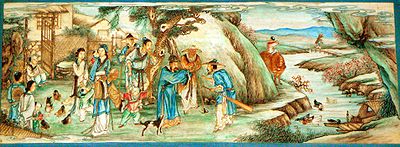穴を抜けると、驚いたことに山の反対側は広い平野になっていたのだった。そこは立ち並ぶ農家も田畑も池も、桑畑もみな立派で美しいところだった。行き交う人々は外の世界の人と同じような衣服を着て、みな微笑みを絶やさず働いていた。
数日間にわたって村の家々を回り、ごちそうされながら外の世界のあれこれ知る限りを話し、感嘆された男だったが、いよいよ自分の家に帰ることにして暇を告げた。村人たちは「ここのことはあまり外の世界では話さないでほしい」と言って男を見送った。穴から出た男は自分の船を見つけ、目印をつけながら川を下って家に戻り、この話を役人に伝えた。役人は捜索隊を出し、目印に沿って川を遡らせたが、ついにあの村の入り口である水源も桃の林も見付けることはできなかった。その後多くの文人・学者らが行こうとしたが、誰もたどり着くことはできなかった。
From Wikipedia, the free encyclopedia
Safflower (
Carthamus tinctorius L.[1]) is a highly branched,
herbaceous,
thistle-like annual, usually with many long sharp spines on the leaves. Plants are 30 to 150 cm tall with globular flower heads (
capitula) and commonly, brilliant yellow, orange or red flowers which bloom in July. Each branch will usually have from one to five flower heads containing 15 to 20 seeds per head. Safflower has a strong
taproot which enables it to thrive in dry climates, but the plant is very susceptible to frost injury from stem elongation to maturity.
Traditionally, the crop was grown for its seeds, and used for colouring and flavouring foods, in medicines, and making red (
carthamin) and yellow dyes, especially before cheaper
aniline dyes became available.
[2] For the last fifty years or so, the plant has been cultivated mainly for the
vegetable oil extracted from its seeds. In April 2007 it was reported that
genetically modified safflower has been bred to create
insulin.
[3]

Safflower purchased at a market in Turkey
Safflower flowers are occasionally used in cooking as a cheaper substitute for
saffron, and are thus sometimes referred to as "bastard saffron." Safflower seed is also used quite commonly as an alternative to
sunflower seed in
birdfeeders, as
squirrels do not like the taste of it.
The pharmaceutical company
SemBioSys Genetics is currently using
transgenic safflower plants to produce human insulin as the global demand for the hormone grows. Safflower-derrived human insulin is currently in the PI/II trials on human test subjects. Phillip Stephan, SemBioSys Genetics Inc, product bulletin June 2008.
[4]
There are two types of safflower that produce different kinds of oil: one high in
monounsaturated fatty acid (
oleic acid) and the other high in
polyunsaturated fatty acid (
linoleic acid). Currently the predominant oil market is for the former, which is lower in saturates than olive oil, for example.
Safflower oil is also used in painting in the place of
linseed oil, particularly with white, as it does not have the yellow tint which linseed oil possesses.
Lana is a strain of Safflower that grows in the southwestern United States, most notably
Arizona and
New Mexico.
In colouring textiles, safflower's dried flowers are used as a natural textile dye.
Natural dyes derived from plants are not widely used in industry but it is getting more important world wide because of naturality and fashion trends. The colourful matter in safflower is
benzoquinone-based
Carthamin, so it is one of the
quinone type natural dyes. It is a
direct dye (CI Natural Red 26) and soluble.
Yellow,
mustard,
khaki,
olive green or even
red colours can be obtained on
textiles, but it is mostly used for yellow colours. All
hydrophilic fibres (all
natural fibres, such as
cotton,
wool, etc.) can be dyed with this plant since it can be classified as a direct dye.
Polyamide can also be dyed without a
mordant agent because of its wool-like chemical structure.
Polyester,
polyacrylnitryl and others which are
hydrophobic synthetic fibres can be dyed only in the existence of a mordant.
[edit]History
Safflower is one of humanity's oldest crops. Chemical analysis of
ancient Egyptian textiles dated to the
Twelfth dynasty identified dyes made from safflower, and garlands made from safflowers were found in the tomb of the
pharaoh Tutankhamun.
[5] John Chadwick reports that the Greek name for safflower occurs many times in
Linear B tablets, distinguished into two kinds: a white safflower, which is measured, and red which is weighed. "The explanation is that there are two parts of the plant which can be used; the pale seeds and the red
florets."
[6]
Other names include Sallflower, Beni, Chimichanga, or Carthamus Tinctorius.
---Wiki
Kaldi
From Wikipedia, the free encyclopedia
According to legend,
Kaldi was the Ethiopian
goatherder who discovered the
coffee plant.
The story is probably apocryphal, as it was first related by Antoine Faustus Nairon, a Maronite who became a Roman professor of Oriental languages and author of one of the first printed treatises devoted to coffee,
De Saluberrima potione Cahue seu Cafe nuncupata Discurscus (Rome, 1671).
[1]
"The myth of Kaldi the Ethiopian goatherd and his dancing goats, the coffee origin story most frequently encountered in Western literature, embellishes the credible tradition that the
Sufi encounter with coffee occurred in Ethiopia, which lies just across the narrow passage of the Red Sea from Arabia's western coast."
[2]
Kaldi, noticing the energizing effects when his flock nibbled on the bright red berries of a certain bush they had become (jumping goats) chewed on the fruit himself. His exhilaration prompted him to bring the berries to an Islamic holy man in a nearby monastery. But the holy man disapproved of their use and threw them into a the fire, from which an enticing aroma billowed. The roasted beans were quickly raked from the embers, ground up, and dissolved in hot water, yielding the world's first cup of coffee.
[3]
[edit]Influence
It also played a small, yet significant role in the
Cold Case episode "Creatures of the Night." The victim, who was planning on opening up an
espresso shop, is told the story of Kaldi by a friend, who gives him a goat-shaped pendant as a "good luck" token. The pendant later turns up as evidence in his murder.






0 件のコメント:
コメントを投稿